Remember when you excitedly installed Windows 8 only to restart your computer to a completely different user interface that left you confused. Where did the Start Menu go? Well, you weren’t the only one – the poor reception to the Windows 8 upgrade was, in large part, because it wasn’t user friendly. Microsoft learned the hard way that changing the user interface in a way that users found less intuitive can kill an upgrade and lead to customer confusion and frustration.
With customized solutions, the needs of end-users change rapidly throughout the life-cycle of a product. Product managers and developers are faced with the dual-challenges of keeping pace with these ever-changing needs while keeping software approachable and user-friendly.
The Agile methodology is rapidly becoming the solution of choice to keep up with these changing needs and facilitate continual product upgrades. However, this approach can be challenging from a user experience perspective. Its pattern of short “sprints” facilitates iterative product releases, but may fail to recognize the importance UX plays in the product’s overall value to the customer.
The problem is a structural one and can be difficult to avoid. Agile was established by developers for developers as a means of delivering value to the business. Its compressed timescale, while expediting the development process, may lead to an avoidance of user testing. UX designers are focused on the needs of the user even at the expense of additional functionality.
Pushing changes without user research is extremely risky; can create a sub-optimal experience for customers; and, at the extreme, lead to a loss of revenue. User testing and reliability must be fit into the short timeframe of a typical sprint-and-release cycle. Design validation and testing can avoid some of the dangers inherent in finalizing developer assumptions.
Here is a summary list of how to maintain user satisfaction with the Agile method:
1. Wireframing and Paper Prototyping
Must be incorporated into the development cycle. Some Agile experts suggest that sprints should be structured around fidelity rather than functionality—especially at the early stages of development.
2. Build in time for user research and testing
Abandoning these important steps can degrade the user experience. Only 55% of companies currently conduct any online user experience testing. Input from direct surveys, social media, and CSM apps can provide a 360° view of needs.
3. Make and manage the product specifications based on user input
Feedback from customers and users should be used in the development of roadmaps, the outlining of new features, and as a guideline to the improving of user interfaces.
4. Test user interfaces
44% of mobile users complain that navigation of mobile websites is difficult. Remember – only the end-users can truly tell you what they think.
5. Focus on benefits to the user
Listen to your customers – Ensure that any new features make the product easier to use or add a needed capability that wasn’t previously available.
6. Make it easy to start using your product
Online interfaces and cloud-based apps make it easy for users to start using your product or service immediately. Avoid downloads or installations if possible.
7. Prevent errors through intuitive online help
..And make it easy to recover from them if they occur. 75% of consumers would prefer using online support if it provided accurate information.
8. Ensure adequate training and support is available
When customers can’t find answers on a website, they call you and drain precious customer support time. Ensure that support engineers are available and adequately prepared, with a thorough understanding of changes in interface and new features. Contextual online help, with guidance tools like WalkMe, can help lower customer support costs.
9. Provide onscreen contextual guidance
For instant user gratification and less support effort. Only 10% to 15% of what is taught in the classroom or spend in training is reflected in long-term behavioral changes. Easily accessible online walkthrough (such as tip balloons or step-by-step guides provided by WalkMe technology) or tutorials (wikis) can help simplify the transition.
Software changes are inevitable—especially as technology evolves and product requirements are expanded. However, from the point-of-view of the end-user, UX is critical to a product’s utility. Changes should not complicate or obfuscate the interface. Fortunately, products such as WalkMe can help smooth the transition and avoid the mistakes of the “Windows 8” experience.


